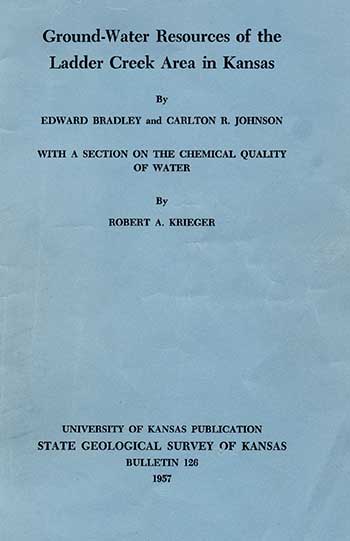Ground-water Resources of the Ladder Creek Area in Kansas
By Edward Bradley and Carlton R. Johnson
With a section on the Chemical Quality of Water
By Robert A. Krieger
Prepared as a part of the program of the Department of Interior for development of the Missouri River basin. The investigation was integrated with the cooperative ground-water program of the United States Geological Survey, the State Geological Survey of Kansas, the Division of Sanitation of the Kansas State Board of Health, and the Division of Water Resources of the Kansas State Board of Agriculture.

Originally published in 1957 as Kansas Geological Survey Bulletin 126. This is, in general, the original text as published. The information has not been updated.
Abstract
This report describes the geology and hydrology of the drainage basin of Ladder Creek in western Kansas. The area investigated includes approximately 1,930 square miles and lies almost entirely within the High Plains section of the Great Plains physiographic province. The easternmost part is in the Plains Border section. Broad upland areas constitute the greatest part of the region under investigation. These upland areas are flat loess-covered plains sloping approximately 10 feet to the mile from west to east and containing many undrained depressions.
The outcropping rocks are sedimentary and range in age from Cretaceous to Quaternary. The Niobrara formation and Pierre shale form a nearly impervious floor beneath the Ladder Creek area, over which have been deposited the Ogallala formation of the Tertiary, and in places, younger deposits of the Quaternary. The principal water-bearing formation is the Ogallala.
The major stream in the area is South Fork of Smoky Hill River, which rises about 35 miles west of the Kansas-Colorado line and flows eastward through most of the area. Ladder Creek is the principal tributary entering this stretch of Smoky Hill River from the south. The flow of Ladder Creek is maintained principally by ground-water discharge from the Ogallala formation through the alluvial valley fill.
Measured depths to water in wells in the Ladder Creek area range from less than 1 foot to 246 feet. In most of the upland area the depth to water ranges from 80 to 150 feet. Transmissibility values obtained from two aquifer tests of the Ogallala formation are 15,000 and 40,000 gpd per foot. An aquifer test of the Sanborn and Meade formations gives a value for transmissibility of about 130,000 gpd per foot.
Deep-well irrigation is in the initial phase despite the great increase in the acreage of irrigated lands in the area in the last few years. The U. S. Bureau of Reclamation has estimated that 435,000 acres of land can be irrigated economically in the area. At the time of this investigation in 1951 about 26,000 acres, or about 6 percent, was developed, of which about 18,000 acres was irrigated annually by about 18,000 acre-feet of ground water.
The ground water in the Ogallala formation, though generally hard, is suitable for most purposes. Calcium and bicarbonate in the water range in concentration from 33 to 84 ppm and 170 to 248 ppm, respectively. The water from the Niobrara Formation contains more dissolved solids than water from the Ogallala formation.
Kansas Geological Survey, Geology
Placed on web Jan. 29, 2013; originally published December 1957.
Comments to webadmin@kgs.ku.edu
The URL for this page is http://www.kgs.ku.edu/Publications/Bulletins/126/index.html